Welcome to our Colossus Movie Guide for Breathless. This guide contains our detailed library of content covering key aspects of the movie’s plot, ending, meaning, and more. We encourage your comments to help us create the best possible guide. Thank you!
What is Breathless about?
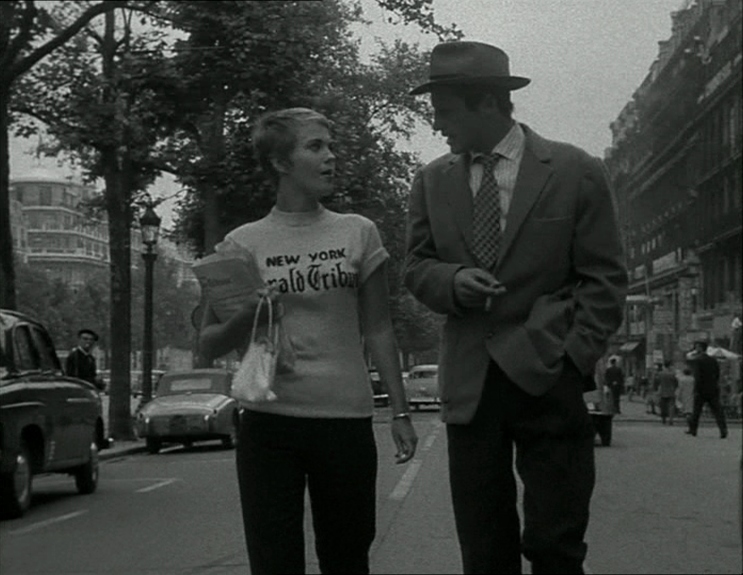
To understand Breathless (aka À bout de souffle), you must understand Godard—a task which seems impossible, given Godard’s own admission that he often has contradictory thoughts, given his disgust of traditional storytelling, his embracement of non-linear narratives. More than anything else, Breathless is a living, breathing story that represents Godard’s sensibilities as an artist, as a critic of both art and the world. And this being his first movie, you can think of Breathless as a sort of coming-of-age mantra; Godard’s first cinematic statement about society and our relationship with movies. As much as we can sit around and evaluate Michel and Patricia’s story like we could any other film with a discernible plot (Breathless is Godard’s most straightforward movie, believe it or not), in order to truly understand Breathless, we must embrace Godard’s irreverent attitude, as it informs the aesthetic of the film as well as our relationship with the characters.
That’s largely what this explanation will be focused on. The history and critical discourse surrounding Breathless takes Godard’s commentary beyond the ordinary. “Instead of writing criticism, I make a film,” said Godard, “even if it means introducing the critical dimension into it.” Yes, the characters of Breathless are living, breathing people with their own journeys that are fascinating to explore. But Michel and Patricia (and several other Breathless characters) serve as archetypes typically found in movies, of popular attitudes regarding cinema observed by Godard himself. And we know all of this because Godard was so candid with his polarizing takes, his unveiled animosity, his unpredictable sentiments. The more we learn about the man and what he wanted to accomplish with his art, the more Breathless reveals itself as a timeless piece of cinema, of striking cultural commentary.
Movie Guide table of contents
Cast
- Jean-Paul Belmondo – Michel Poiccard
- Jean Seberg – Patricia Franchini
- Daniel Boulanger – Police Inspector Vital
- Henri-Jacques Huet – Antonio Berruti
- Roger Hanin – Carl Zumbach
- Van Doude – Van Doude
- Liliane Dreyfus – Liliane
- Jean-Pierre Melville – Parvulesco
- Jean-Luc Godard – Writer and director
The DIY, low-budget vigor of Breathless

Let’s start at the beginning, the very beginning, before we even meet Michel. Godard dedicates the film to Monogram Pictures—a studio he never covered while writing reviews at Cahiers du cinema, that didn’t last very long. Monogram only made a handful of low-budget westerns, and is largely remembered for its 48 films that featured The Bowery Boys. But, as Jonathan Rosenbaum points out in his “Breathless” as Criticism video essay for the Criterion Collection, that because Godard was shooting on the fly and without proper sound, he wanted to establish an aesthetic alliance related to impoverished budgets. This “dedication” is less of a fan’s homage, and more of a critical statement of Godard’s aims and boundaries and how we wants us to perceive the film.
As one of the founders of the French New Wave film movement (which included the likes of François Truffaut, Éric Rohmer, Jacques Rivette, and Claude Chabrol), it was important for Godard and his colleagues to separate themselves from the standard Hollywood fare, the standard French (as well as other popular European) films they believed were settling into complacency. Which meant approaching scenes in a different manner. Thus, Godard was not deterred by his lack of budget, and in fact embraced the liberation such poverty provided. For instance, Godard would never change locations, which was expensive and time-consuming, and would always complete shooting in the designated amount of time. (In fact, Godard was often so economical with his shooting that there wouldn’t be enough footage to fill the movie, which meant subsequently shooting and then splicing in simple scenes such as Michel reading a newspaper.)
These kinds of examples go on and on: Godard shot the film on a handheld camera, which only takes about 30 minutes to set up on a tripod, and he would often just follow around his actors and let them improvis; he would write dialogue on the morning of shoots; he would use a wheelchair instead of a standard, professional dolly setup; several men were crammed together to shoot the scenes in Patricia’s apartment; all dialogue had to be recorded later because the camera was too loud. Essentially, Godard was there to make a movie and nothing would stand in his way. His approach was to simply get as much material on camera as possible and worry about editing later.
As a result, a new, invigorating aesthetic was born from Breathless. The post-production process of Breathless, such as the editing, played a huge role, but the pull-yourself-up-by-the-bootstraps approach to actually filming the material had perhaps even more influence on artists in the years to come. As the film’s cinematographer Raoul Coutard put it:
Breathless set certain people free who wanted to make films differently, especially some Americans…It certainly influenced French cinema, because we started shooting on location inside houses. Also, new lighting material was developed: quartz lighting, the Colortron, the HIMs, all those things, which prepared the way for what TV would later develop. But in my opinion, it was all part of cinema’s technological and intellectual advances.
Godard’s homage to American gangster films
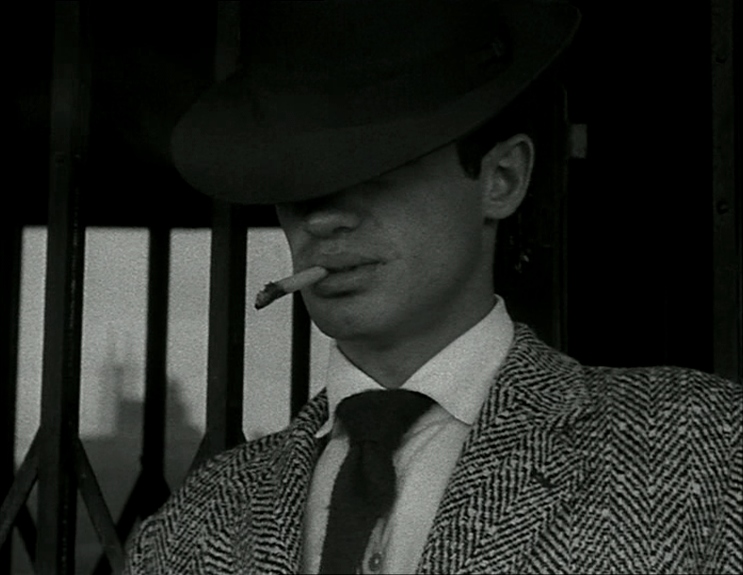
The movie opens on Michel as he stands behind a newspaper and says, “After all, I’m an asshole. After all, yes, I’ve got to. I’ve got to!” He then reveals his face, smoking a cartoonishly large cigarette, as he looks off into the distance. He then brings his thumb up to circle his lips—the first real moment of Breathless where Godard grabs us and forces us into viewing submission. It’s an electric moment that means nothing in the current context of the story, but represents everything Godard has been desperate to express with his debut feature film.
Godard said in an interview found on the Criterion Collection disc that Breathless was about a gangster, like the characters Humphrey Bogart and Jean Gabin used to play. And indeed, this opening quote is a nod to the kind of introspection Bogie (Bogart’s nickname) would employ with his characters, and this stroking of the lips is a nod to the actor’s manly mannerisms in American gangster films. But Breathless is much more than that. It is not reverence—it is (as critic Jonathan Rosenbaum points out in his “Breathless” as Criticism video essay) criticism.
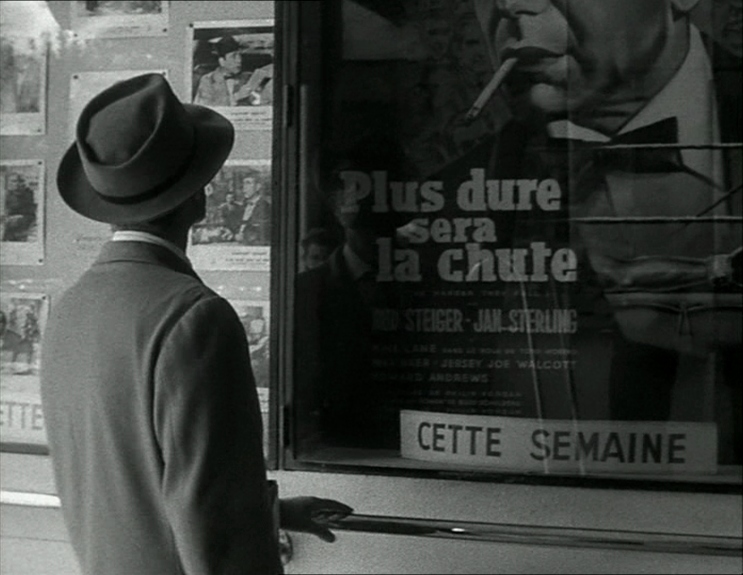
We can see that Michel reveres Bogart when he stares at the The Harder They Fall poster in the theater window and directs cigarette smoke at his picture—as if, as Rosenbaum eloquently puts it, “it were holy incense.” His young, awkward, often contradictory attempts to appear hardened and immovable create an interesting character who’s both despicable and undeniably innocent. He’s got rugged good looks like Bogart, but none of the Hollywood charm we expect from movie leads. He strives to rebel, to become someone who exists outside the monotonous system, and often attempts this at the expense of others (I’m thinking of the cop he shoots). His attempts are silly and sad, like here at the beginning of the movie when he wants to create an image of coldheartedness…but then just pettily steals some dude’s car. He’s a complete conundrum that often loses our respect yet gains our sympathy.
By creating such a complicated character, Godard goes beyond the cool, stylized anti-hero we expected from American gangster films, and in turn criticizes what we’ve come to expect from this sort of narrative. Suddenly, the typical muted camaraderie we shared with these sort of aged, grizzled anti-hero characters (who only lurk in the darkest shadows of culture and society because America made them that way) is in flux with someone like Michel. The character imitates American gangsters on his very surface, only to completely upend the traditional mold. We are inherently meant to identify with him, as is traditional with film noir, yet Michel constantly pushes us away. He is a hero with no redeeming qualities beyond wanting to feel something in his rebellion. It’s an almost mocking move on Godard’s part—a bold, antagonistic opening statement that directly challenges the cultural communal view of such a familiar presence.
The avant-garde editing of Breathless
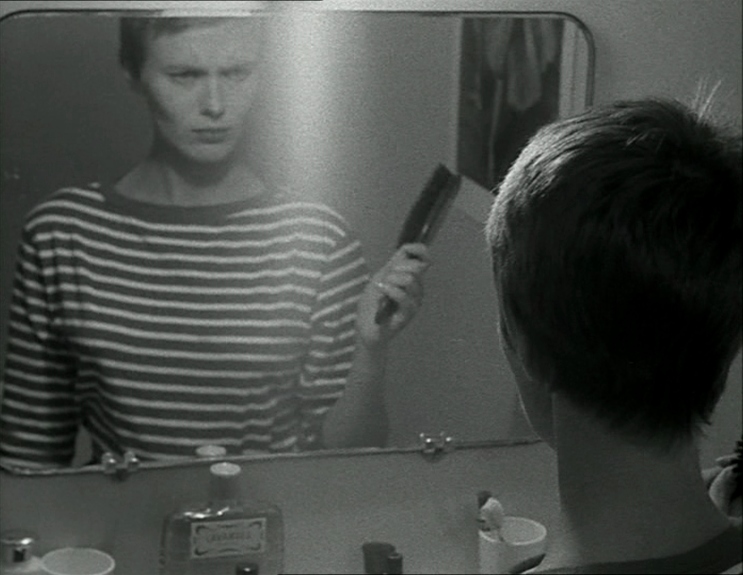
There’s an eye-catching, highly stylized moment towards the beginning of the film that primes us for the type of editing employed by Godard. Michel is driving his stolen car and trying to shake off the cops, so he pulls down a side road and parks. But one of the cops spots him. The cop approaches and says, “Hold it right there!” But Michel reaches into the car to grab his newly found gun. Then, the camera pans down from Michel’s hat to his arm, then pans right to the gun. Then we get a close-up of the gun as he shoots and the cop falls to the ground. Michel then takes off running.
This sequence is a preview of what we’ll see throughout Breathless: shots chopped up and strung together for dramatic effect. The movie is perhaps most famous for its jump cuts, for its absolutely unmatched approach to editing and narrative construction. And there’s an important philosophy behind this revolutionary style of editing that informs our reading of the film.
As I mentioned earlier, it’s important to note that Breathless is Godard’s first feature, as the films becomes sort of creed reflecting years of thoughts and opinions he had accrued on how to make a great movie. Before he made films, he was a critic, and often had gripes with filmmakers who didn’t enliven their material with spirit and fervor—a style which Godard believed truly brought us in closed quarters with the characters. Which explains why he (and the rest of the French New Wave) loved Alfred Hitchcock so much. Before Godard ever directed a film, even a short one, he wrote this review of Hitchcock’s Strangers on a Train, which perfectly captures his thoughts on editing and pacing:
From German Expressionism, Hitchcock consciously retains a certain stylization of attitude, emotions being the result of a persistent purpose rather than of impetuous passion: it is through his actions that the actor finally becomes simply the instrument of action, and that only this action is natural; space is the impulse of a desire, and time its effort towards accomplishment.
In my opinion, this quote effective conveys what Godard wants from a well-edited sequence. Movies are filled with conversation, with contemplation, with the stagnancy of life that occurs in between action (the space). It’s in these moments that we learn about the characters and who they are and what their “persistent purpose” is. These truths then informs the actions. Which means when there is action, the action should be just as revelatory and revealing, should further clue us into the character. In terms of Strangers on a Train, Godard notes two famous scenes (the strangulation and the merry-go-round) in his review which contain the kind of frenetic editing we see in Breathless‘s gun scene.
Mise en scene forces us to imagine an object in its signification; but these clever and violent effects are so only to transmit the drama to the spectator at its highest level—I refer, of course, to the strangling in the woods and the struggle on the merry-go-round, scenes which contain so many astonishing realities, such depth in their fantastic frenzy, that I fancy I breathe in them a gentle odor of profanation. The truth is that there is no terror untempered by some great moral idea. Should one reproach this renowned filmmaker for flirting with appearances? Certainly the camera defies reality, but does not evade it; if it enters the presents it is to give it the style it lacks.
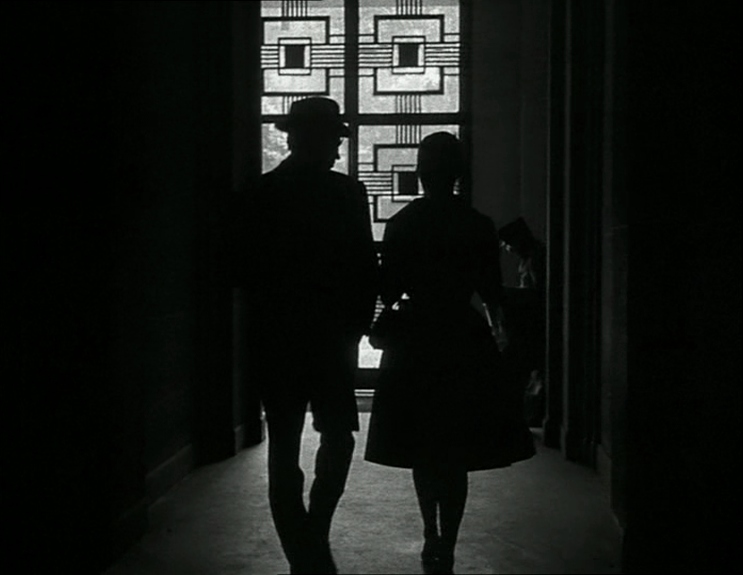
You see, for Godard, these highly stylized moments don’t bring us out of the action and reflect artistic fantasy, but instead bring us into the characters’ lives and reflect existence. That moment where Michel shoots the cop doesn’t reflect the “present” in terms of what we see. But the editing comes to reflect how Michel experiences the moment.
I believe that last sentence of the quote becomes an editing mantra for Godard: the camera defies reality to give the present the style it lacks. Movies shouldn’t be boring in the way that life isn’t boring. When a movie makes life boring, it isn’t a proper reflection of life, which is filled with an amalgamation of emotions that results in an existence that is anything but ordinary, that isn not easily depicted and captured by art.
Funny enough, Godard didn’t know how he was going to cut together the film until he got into the editing room. It was part of the filmmaker’s step-by-step approach to filmmaking, as he was often write dialogue and construct scenes on the day of shooting. As Breathless‘s cinematographer Raoul Coutard said, “There was a panache to the way it was edited that didn’t match at all the way it was shot. The editing gave it a very different tone than the films we were used to seeing. And the story had a liveliness that ‘classic films’ just didn’t have back then.” So there was also an element of wanting to do things differently than other filmmakers, to bring electricity to the film that challenged how the viewer associated with this very familiar and archetypical gangster character.
The philosophical insight of Michel and Patricia’s love

While driving to Paris, Michel states his plan out loud to himself: woo Patricia, collect the money owed to him, and then flee town. He steals the car and shoots the policeman because he’s in a hurry, because he doesn’t plan on staying in France for long. He is on the run not from the law, but from the system which constricts him, which hasn’t allowed him to become the powerful, content figure he strives to be.
Patricia is the antithesis to Michel’s waywardness and ego. She is rather satisfied in Paris, realistic about her situation and comfortable with her restrained lifestyle. She isn’t angry about the parameters set by society or uncomfortable about the type of woman she’s become. And there’s nothing trivial about her outlook. She simply finds solace in the quaintness of life.
The second these two meet each other, we are aware of their differences, of the philosophical tension that exists between them. Patricia often reflects on literature and paintings, while Michel’s references lie in movies; she is attuned to the past and what shaped the world around her, while he is obsessed with the glamorized picture of rebellious, solitary men fighting the system; she romanticizes, while Michel sexualizes (“Do you know William Faulkner?” Patricia asks, to which Michel responds, “No. Who’s he? Have you slept with him?”).
Patricia is also, as Mike Rappaport noted in his Jean Seberg documentary for the Criterion Collection, an American outsider to France. While Michel’s moral moral failings are clear and obvious given his years of subjugation under the French system, Patricia’s have not been fully tapped. Part of the her journey is experiencing French society juxtaposed with Michel; observing how the world can corrupt and alienate people and drive them to despicable ends. And we observe how that view shapes her and her decisions.
Despite their differences, there’s one last important thing to note: Michel and Patricia are lovers. The way in which that love is expressed is complicated and often changes, but ultimately these two opposing mentalities find cohesion. Thus, their relationship comes to reflect a natural cognitive dissonance in the world. They argue and challenge one another in throughout their philosophical discussions, yet the entire time appear to grow closer and closer together; they disagree about life and how to live it, but enliven each other and inspire such spirit; they push each other away, yet become more and more inextricably bound together. It’s a precarious but loving relationship that inevitably leads to destruction.
In my opinion, Godard wanted to present a complicated and cataclysmic, yet ultimately comforting view of society through Michel and Patricia. Their dynamic reflects an almost masochistic desire to better understand the world, to challenge the status quo and push both ourselves and each other to the fringes. Our collective growth as society is a tricky, troubled path, and catharsis and enlightenment are not easily attainable. Yet we chase it, and are attracted to the personas that challenge our worldviews the most, that force us to refine our philosophies and outlooks on the world.
Now it’s your turn
Have more unanswered questions about Breathless? Are there themes or motifs we missed? Is there more to explain about the ending? Please post your questions and thoughts in the comments section! We’ll do our best to address every one of them. If we like what you have to say, you could become part of our movie guide!

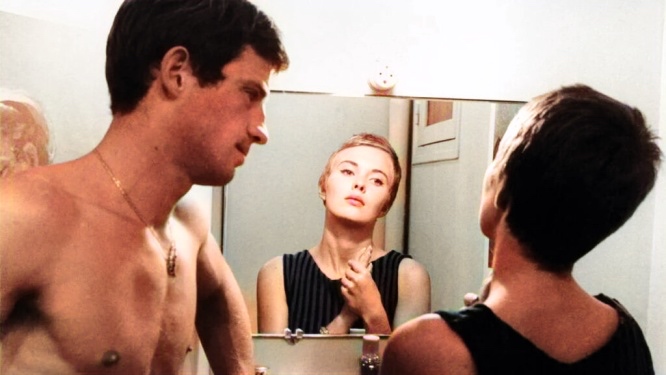
Fantastic write-up of one of the most intriguing movies in history.
Thank you! I actually want to write quite a bit more about the film, especially the facial gestures. Hopefully I can find the time someday.